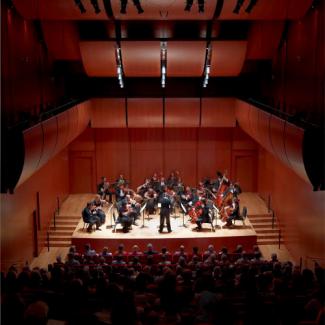A complex of buildings in the heart of New York City, The Morgan Library & Museum began as the private library of financier Pierpont Morgan (1837–1913), one of the preeminent collectors and cultural benefactors in the United States. As early as 1890 Morgan had begun to assemble a collection of illuminated, literary, and historical manuscripts, early printed books, and old master drawings and prints.
Mr. Morgan's library, as it was known in his lifetime, was built between 1902 and 1906 adjacent to his New York residence at Madison Avenue and 36th Street. Designed by Charles McKim of the architectural firm McKim, Mead & White, the library was intended as something more than a repository of rare materials. Majestic in appearance yet intimate in scale, the structure was to reflect the nature and stature of its holdings. The result was an Italian Renaissance-style palazzo with three magnificent rooms epitomizing America's Age of Elegance. Completed three years before McKim's death, it is considered by many to be his masterpiece. In 1924, eleven years after Pierpont Morgan's death, his son, J. P. Morgan, Jr. (1867–1943), known as Jack, realized that the library had become too important to remain in private hands. In what constituted one of the most momentous cultural gifts in U.S. history, he fulfilled his father's dream of making the library and its treasures available to scholars and the public alike by transforming it into a public institution.
Over the years—through purchases and generous gifts—The Morgan Library & Museum has continued to acquire rare materials as well as important music manuscripts, early children's books, Americana, and materials from the twentieth century. Without losing its decidedly domestic feeling, the Morgan also has expanded its physical space considerably.
In 1928, the Annex building was erected on the corner of Madison Avenue and 36th Street, replacing Pierpont Morgan's residence. The Annex connected to the original McKim library by means of a gallery. In 1988, Jack Morgan's former residence—a mid-nineteenth century brownstone on Madison Avenue and 37th Street—also was added to the complex. The 1991 garden court was constructed as a means to unite the various elements of the Morgan campus.
The largest expansion in the Morgan's history, adding 75,000 square feet to the campus, was completed in 2006. Designed by Pritzker Prize–winning architect Renzo Piano, the project increases exhibition space by more than fifty percent and adds important visitor amenities, including a new performance hall, a welcoming entrance on Madison Avenue, a new café and a new restaurant, a shop, a new reading room, and collections storage. Piano's design integrates the Morgan's three historical buildings with three new modestly scaled steel-and-glass pavilions. A soaring central court connects the buildings and serves as a gathering place for visitors in the spirit of an Italian piazza.

